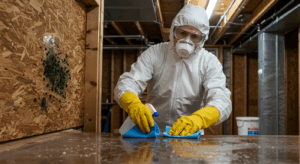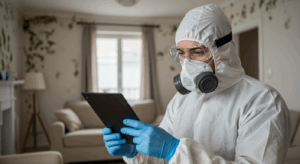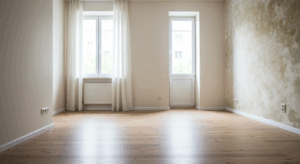Discovering mold in your basement can be alarming, but it’s a common issue that many homeowners face. Mold thrives in damp, dark environments, making basements a prime location for its growth. Left unchecked, mold can pose serious health risks and structural issues. This guide will help you identify, remove, and prevent mold in your basement, ensuring a safe and healthy home environment.
Understanding Mold in Basements
Common Types of Mold Found in Basements
Basements often host various types of mold, including black mold (Stachybotrys), green mold (Cladosporium), and white mold (Aspergillus). Black mold is particularly concerning due to its toxic nature, while green and white molds are more common but still harmful. Mold spores spread quickly in moist conditions, attaching to walls, floors, and even furniture. Recognizing the type of mold is the first step in addressing the problem effectively.
Health Risks Associated with Mold Exposure
Mold exposure can lead to a range of health issues, especially for individuals with allergies, asthma, or weakened immune systems. Symptoms include respiratory problems, skin irritation, and headaches. Prolonged exposure to toxic molds like black mold can cause severe health complications, including neurological issues. Protecting your family’s health starts with identifying and eliminating mold promptly.
Identifying Mold Presence
Signs of Mold: Smells and Visual Indicators
Mold often reveals itself through a musty odor, even before it becomes visible. Check for discoloration on walls, ceilings, and floors, as mold typically appears as black, green, or white patches. Peeling paint, water stains, and warped wood are also indicators of mold growth. Regularly inspecting your basement can help you catch mold early.
Testing for Mold: DIY Methods and When to Call Professionals
DIY mold testing kits are a cost-effective way to confirm mold presence. These kits typically include petri dishes and swabs to collect samples, which can then be sent to a lab for analysis. However, if you suspect extensive mold growth or toxic black mold, it’s best to hire professionals for thorough testing and remediation. Learn more about comprehensive mold testing and removal services in Evanston, WY.
Effective Mold Removal Strategies
Step-by-Step Mold Removal Process
- Assess the Area: Determine the extent of mold growth and identify the affected areas.
- Prepare the Space: Seal off the area to prevent mold spores from spreading to other parts of your home.
- Use Cleaning Solutions: Apply a mixture of water and detergent or a commercial mold remover to scrub the mold off surfaces.
- Dry the Area Thoroughly: Use fans and dehumidifiers to dry the space completely, as moisture encourages mold regrowth.
- Dispose of Contaminated Materials: Safely discard any items that cannot be cleaned, such as carpets or drywall.
For severe infestations, professional mold remediation services are recommended to ensure complete removal. Explore effective black mold removal solutions in Cheyenne, WY.
Safety Precautions: Personal Protective Equipment (PPE)
When dealing with mold, it’s crucial to protect yourself. Wear gloves, goggles, and an N95 respirator mask to minimize exposure to mold spores. Ensure proper ventilation in the workspace to reduce inhalation risks. Taking these precautions will safeguard your health during the removal process.
Preventing Future Mold Growth
Moisture Control: Tips for a Dry Basement
Controlling moisture is key to preventing mold growth. Start by addressing any leaks or water seepage in your basement. Use a dehumidifier to maintain humidity levels below 50%, and ensure proper ventilation to reduce condensation. Installing a sump pump can also help manage water accumulation during heavy rains. Discover more about mold removal and prevention in Evanston, WY.
Long-Term Solutions: Waterproofing and Maintenance
Investing in waterproofing solutions, such as sealing cracks in walls and floors, can provide long-term protection against mold. Regular maintenance, including cleaning gutters and inspecting your foundation, will also help keep your basement dry. Monitoring humidity levels with a hygrometer is an easy way to stay proactive.

Conclusion
Finding mold in your basement can be daunting, but with the right approach, you can tackle the issue effectively. By understanding the types of mold, identifying its presence, and following proper removal and prevention strategies, you can protect your home and family from the risks associated with mold. Remember, early detection and consistent maintenance are key to keeping your basement mold-free. If the problem persists, don’t hesitate to seek professional help to ensure a safe and healthy living environment.




